少林寺介绍(英语)PPT课件
- 格式:ppt
- 大小:5.03 MB
- 文档页数:42
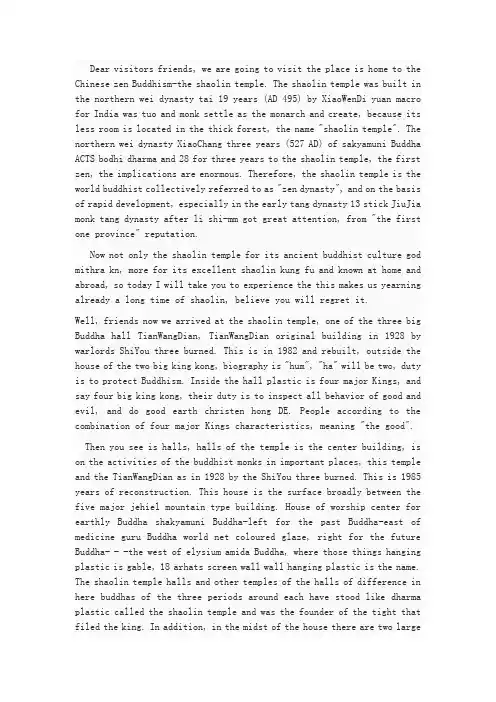
Dear visitors friends, we are going to visit the place is home to the Chinese zen Buddhism-the shaolin temple. The shaolin temple was built in the northern wei dynasty tai 19 years (AD 495) by XiaoWenDi yuan macro for India was tuo and monk settle as the monarch and create, because its less room is located in the thick forest, the name "shaolin temple". The northern wei dynasty XiaoChang three years (527 AD) of sakyamuni Buddha ACTS bodhi dharma and 28 for three years to the shaolin temple, the first zen, the implications are enormous. Therefore, the shaolin temple is the world buddhist collectively referred to as "zen dynasty", and on the basis of rapid development, especially in the early tang dynasty 13 stick JiuJia monk tang dynasty after li shi-mm got great attention, from "the first one province" reputation.Now not only the shaolin temple for its ancient buddhist culture god mithra kn, more for its excellent shaolin kung fu and known at home and abroad, so today I will take you to experience the this makes us yearning already a long time of shaolin, believe you will regret it.Well, friends now we arrived at the shaolin temple, one of the three big Buddha hall TianWangDian, TianWangDian original building in 1928 by warlords ShiYou three burned. This is in 1982 and rebuilt, outside the house of the two big king kong, biography is "hum", "ha" will be two, duty is to protect Buddhism. Inside the hall plastic is four major Kings, and say four big king kong, their duty is to inspect all behavior of good and evil, and do good earth christen hong DE. People according to the combination of four major Kings characteristics, meaning "the good".Then you see is halls, halls of the temple is the center building, is on the activities of the buddhist monks in important places, this temple and the TianWangDian as in 1928 by the ShiYou three burned. This is 1985 years of reconstruction. This house is the surface broadly between the five major jehiel mountain type building. House of worship center for earthly Buddha shakyamuni Buddha-left for the past Buddha-east of medicine guru Buddha world net coloured glaze, right for the future Buddha- - -the west of elysium amida Buddha, where those things hanging plastic is gable, 18 arhats screen wall wall hanging plastic is the name. The shaolin temple halls and other temples of the halls of difference in here buddhas of the three periods around each have stood like dharma plastic called the shaolin temple and was the founder of the tight that filed the king. In addition, in the midst of the house there are two largeunder column and kylin statues and indicated the zen Buddhism is completely localization of Chinese Buddhism.Below is the shaolin temple?-the third hall sutra depository leisurely, another name FaTang, built in the Ming dynasty, destroyed in 1928, and rebuilt in 1994, it is the place that the scripture-stored temple monks, said to the collection is yi jin jing, diamond sutra, such as establishment such as palm the mystery of secret powers permission to land. Before the sutra depository leisurely inscriptions many, this also is the shaolin temple "thousands" (tablet more, tower, mural) one of the characteristics. The shaolin temple in the sutra depository leisurely for a Burma countries disciple in 1996 with yi's white marble sleeping Buddha like a statue. The sutra depository leisurely channel east side, have a big iron wok, weight 1300 jins, is the wanli four years (1576 AD) cast, it is said that is the peak temple with cooking. Enough to imagine, Ming ding period, many of the temple monks and stick exuberant.Good friends, want to continue to understand the culture of shaolin temple and charm you, come with me.。


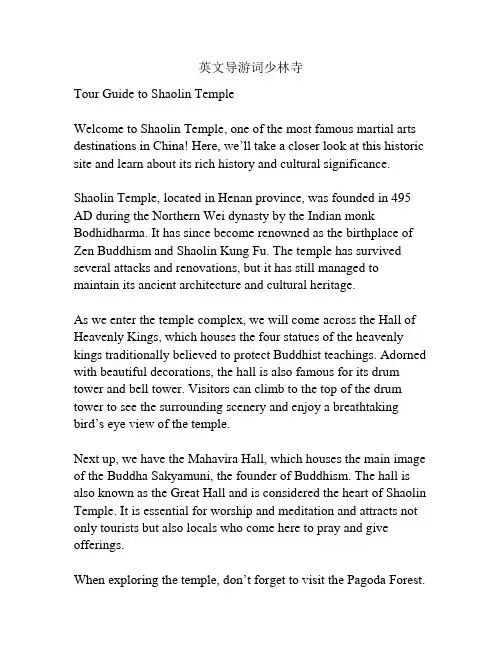
英文导游词少林寺Tour Guide to Shaolin TempleWelcome to Shaolin Temple, one of the most famous martial arts destinations in China! Here, we’ll take a closer look at this historic site and learn about its rich history and cultural significance.Shaolin Temple, located in Henan province, was founded in 495 AD during the Northern Wei dynasty by the Indian monk Bodhidharma. It has since become renowned as the birthplace of Zen Buddhism and Shaolin Kung Fu. The temple has survived several attacks and renovations, but it has still managed to maintain its ancient architecture and cultural heritage.As we enter the temple complex, we will come across the Hall of Heavenly Kings, which houses the four statues of the heavenly kings traditionally believed to protect Buddhist teachings. Adorned with beautiful decorations, the hall is also famous for its drum tower and bell tower. Visitors can climb to the top of the drum tower to see the surrounding scenery and enjoy a breathtaking bird’s eye view of the temple.Next up, we have the Mahavira Hall, which houses the main image of the Buddha Sakyamuni, the founder of Buddhism. The hall is also known as the Great Hall and is considered the heart of Shaolin Temple. It is essential for worship and meditation and attracts not only tourists but also locals who come here to pray and give offerings.When exploring the temple, don’t forget to visit the Pagoda Forest.The Pagoda Forest is the largest group of ancient pagodas in China, and it’s located on the east side of the temple. Shaolin Temple’s Pagoda Forest consists of about 200 stone or brick pagodas built during the Tang, Song, Jin, and Yuan dynasties, with the oldest one dating back to the Eastern Wei dynasty (534-550).Now, let’s talk about what Shaolin Temple is most famous for –Kung Fu. Shaolin Kung Fu is a traditional Chinese martial art that has been practiced by monks since the Tang dynasty. Shaolin Temple is the birthplace of this art, and we can see some impressive performances of Kung Fu by the Shaolin monks here. You might even witness some monks demonstrating their unique moves, including the Shaolin stick, the one-finger handstand, and the iron head.Finally, you must visit the Shaolin Temple’s museum, where a vast array of ancient relics, photos, and works of art are preserved. The museum provides an excellent introduction to the history and culture of the Shaolin Temple.In conclusion, Shaolin Temple is a must-visit for anyone interested in China's culture or martial arts. Whether you come here to experience the Kung Fu performances, explore the ancient architecture, or just soak up the atmosphere, there is something here for everyone. Thank you for visiting, and I hope this tour has given you an insight into Shaolin Temple and its cultural significance.Beyond the physical sites and attractions, Shaolin Temple is a spiritual and cultural destination that offers visitors a unique opportunity to learn more about Zen Buddhism and Chinese philosophy. In addition to its temples and pagodas, thetemple complex features meditation rooms, where visitors can try their hand at Zen meditation techniques, and experience the peaceful state of mind that the practice can evoke.For those who are interested in taking their Kung Fu experience even further, Shaolin Temple offers training courses where participants can learn the techniques and traditions of Shaolin Kung Fu from the monks themselves. The courses range from one week to several months, and students receive instruction in hand-to-hand combat, weapon arts, and empty-hand forms.Moreover, the Shaolin Temple has played a significant role in spreading Chinese culture and martial arts to the rest of the world. In recent years, the temple has hosted international arts competitions, which showcase traditional Kung Fu, Tai Chi, and other martial arts from around the world. These events provide an excellent opportunity for cultural exchange and dialogue and promote understanding and respect between different cultures.However, Shaolin Temple is not just a tourist destination. It remains an active place of worship and spiritual reflection for millions of Buddhists worldwide. As a result, visitors must respect the temple's solemn atmosphere and adhere to the strict dress code that prohibits revealing clothing. In addition, visitors should be aware that photography of the temple's interior is not permitted due to the religious sensitivity of the site.In conclusion, Shaolin Temple is a remarkable destination that provides visitors with an unparalleled opportunity to immerse themselves in the rich history, culture, and spirituality that defineChina. Whether you are a martial arts enthusiast, a history buff, or someone seeking a true cultural experience, Shaolin Temple offers something for everyone. So why not embark on a journey to this captivating destination and discover the hidden gems waiting to be explored within this ancient temple complex?。
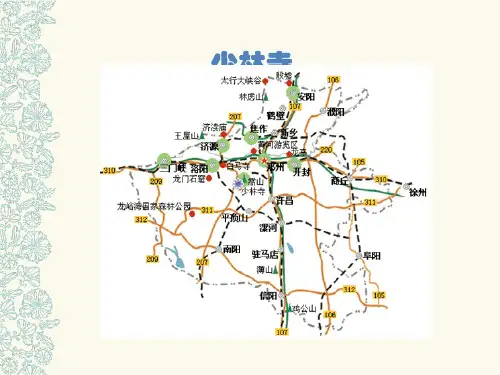
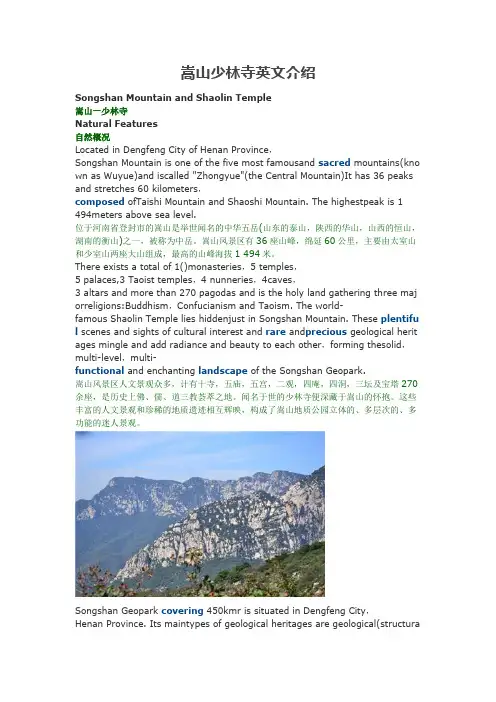
嵩山少林寺英文介绍Songshan Mountain and Shaolin Temple嵩山—少林寺Natural Features自然概况Located in Dengfeng City of Henan Province,Songshan Mountain is one of the five most famousand sacred mountains(kno wn as Wuyue)and iscalled "Zhongyue"(the Central Mountain)It has 36 peaks and stretches 60 kilometers,composed ofTaishi Mountain and Shaoshi Mountain. The highestpeak is 1 494meters above sea level.位于河南省登封市的嵩山是举世闻名的中华五岳(山东的泰山,陕西的华山,山西的恒山,湖南的衡山)之一,被称为中岳。
嵩山风景区有36座山峰,绵延60公里,主要由太室山和少室山两座大山组成,最高的山峰海拔1 494米。
There exists a total of 1()monasteries,5 temples,5 palaces,3 Taoist temples,4 nunneries,4caves,3 altars and more than 270 pagodas and is the holy land gathering three maj orreligions:Buddhism,Confucianism and Taoism. The world-famous Shaolin Temple lies hiddenjust in Songshan Mountain. These plentifu l scenes and sights of cultural interest and rare and precious geological herit ages mingle and add radiance and beauty to each other,forming thesolid,multi-level,multi-functional and enchanting landscape of the Songshan Geopark.嵩山风景区人文景观众多,计有十寺,五庙,五宫,二观,四庵,四洞,三坛及宝塔270余座,是历史上佛、儒、道三教荟萃之地。

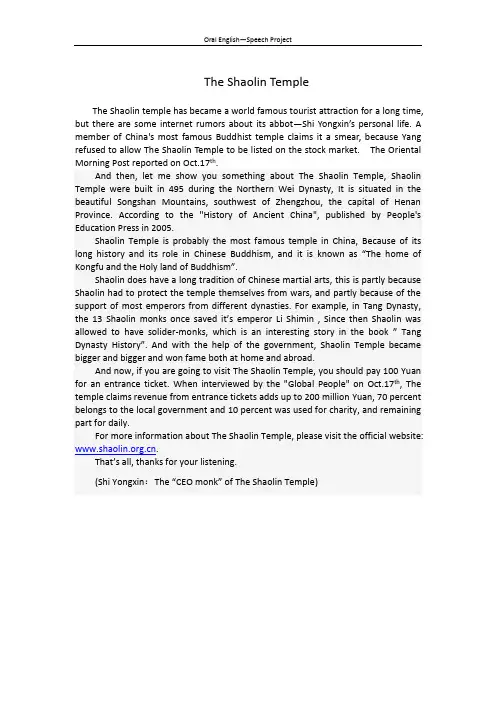
Oral English—Speech ProjectThe Shaolin TempleThe Shaolin temple has became a world famous tourist attraction for a long time, but there are some internet rumors about its abbot—Shi Yongxin’s personal life. A member of China's most famous Buddhist temple claims it a smear, because Yang refused to allow The Shaolin Temple to be listed on the stock market.The Oriental Morning Post reported on Oct.17th.And then, let me show you something about The Shaolin Temple,Shaolin Temple were built in 495 during the Northern Wei Dynasty,It is situated in the beautiful Songshan Mountains, southwest of Zhengzhou, the capital of Henan Province. According to the "History of Ancient China", published by People's Education Press in 2005.Shaolin Temple is probably the most famous temple in China, Because of its long history and its role in Chinese Buddhism, and it is known as “The home of Kongfu and the Holy land of Buddhism”.Shaolin does have a long tradition of Chinese martial arts, this is partly because Shaolin had to protect the temple themselves from wars, and partly because of the support of most emperors from different dynasties. For example, in Tang Dynasty, the 13 Shaolin monks once saved it’s emperor Li Shimin , Since then Shaolin was allowed to have solider-monks, which is an interesting story in the book ”Tang Dynasty History”. And with the help of the government, Shaolin Temple became bigger and bigger and won fame both at home and abroad.And now, if you are going to visit The Shaolin Temple, you should pay 100 Yuan for an entrance ticket.When interviewed by the "Global People" on Oct.17th, The temple claims revenue from entrance tickets adds up to 200 million Yuan, 70 percent belongs to the local government and 10 percent was used for charity, and remaining part for daily.For more information about The Shaolin Temple, please visit the official website: .That’s all, thanks for your listening.(Shi Yongxin:The “CEO monk” of The Shaolin Temple)。
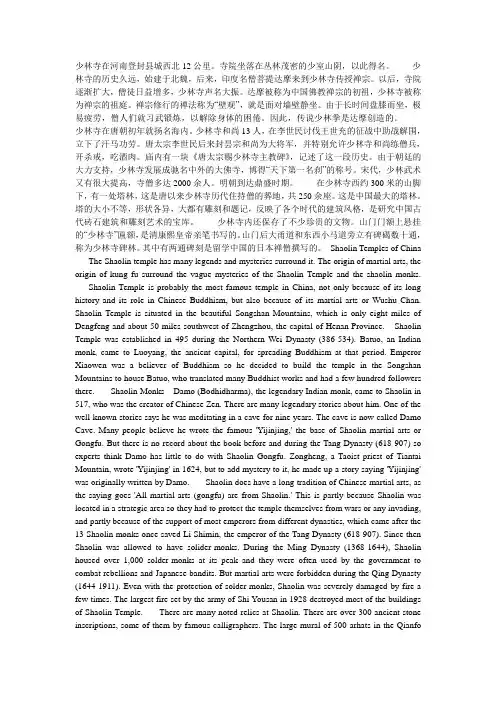
少林寺在河南登封县城西北12公里。
寺院坐落在丛林茂密的少室山阴,以此得名。
少林寺的历史久远,始建于北魏,后来,印度名僧菩提达摩来到少林寺传授禅宗。
以后,寺院逐渐扩大,僧徒日益增多,少林寺声名大振。
达摩被称为中国佛教禅宗的初祖,少林寺被称为禅宗的祖庭。
禅宗修行的禅法称为“壁观”,就是面对墙壁静坐。
由于长时间盘膝而坐,极易疲劳,僧人们就习武锻炼,以解除身体的困倦。
因此,传说少林拳是达摩创造的。
少林寺在唐朝初年就扬名海内。
少林寺和尚13人,在李世民讨伐王世充的征战中助战解围,立下了汗马功劳。
唐太宗李世民后来封昙宗和尚为大将军,并特别允许少林寺和尚练僧兵,开杀戒,吃酒肉。
庙内有一块《唐太宗赐少林寺主教碑》,记述了这一段历史。
由于朝廷的大力支持,少林寺发展成驰名中外的大佛寺,博得“天下第一名刹”的称号。
宋代,少林武术又有很大提高,寺僧多达2000余人。
明朝到达鼎盛时期。
在少林寺西约300米的山脚下,有一处塔林,这是唐以来少林寺历代住持僧的葬地,共250余座。
这是中国最大的塔林。
塔的大小不等,形状各异,大都有雕刻和题记,反映了各个时代的建筑风格,是研究中国古代砖石建筑和雕刻艺术的宝库。
少林寺内还保存了不少珍贵的文物。
山门门额上悬挂的“少林寺”匾额,是清康熙皇帝亲笔书写的。
山门后大甬道和东西小马道旁立有碑碣数十通,称为少林寺碑林。
其中有两通碑刻是留学中国的日本禅僧撰写的。
Shaolin Temples of China The Shaolin temple has many legends and mysteries surround it. The origin of martial arts, the origin of kung fu surround the vague mysteries of the Shaolin Temple and the shaolin monks. Shaolin Temple is probably the most famous temple in China, not only because of its long history and its role in Chinese Buddhism, but also because of its martial arts or Wushu Chan. Shaolin Temple is situated in the beautiful Songshan Mountains, which is only eight miles of Dengfeng and about 50 miles southwest of Zhengzhou, the capital of Henan Province. Shaolin Temple was established in 495 during the Northern Wei Dynasty (386-534). Batuo, an Indian monk, came to Luoyang, the ancient capital, for spreading Buddhism at that period. Emperor Xiaowen was a believer of Buddhism so he decided to build the temple in the Songshan Mountains to house Batuo, who translated many Buddhist works and had a few hundred followers there. Shaolin Monks Damo (Bodhidharma), the legendary Indian monk, came to Shaolin in 517, who was the creator of Chinese Zen. There are many legendary stories about him. One of the well-known stories says he was meditating in a cave for nine years. The cave is now called Damo Cave. Many people believe he wrote the famous 'Y ijinjing,' the base of Shaolin martial arts or Gongfu. But there is no record about the book before and during the Tang Dynasty (618-907) so experts think Damo has little to do with Shaolin Gongfu. Zongheng, a Taoist priest of Tiantai Mountain, wrote 'Yijinjing' in 1624, but to add mystery to it, he made up a story saying 'Yijinjing' was originally written by Damo. Shaolin does have a long tradition of Chinese martial arts, as the saying goes 'All martial arts (gongfu) are from Shaolin.' This is partly because Shaolin was located in a strategic area so they had to protect the temple themselves from wars or any invading, and partly because of the support of most emperors from different dynasties, which came after the 13 Shaolin monks once saved Li Shimin, the emperor of the Tang Dynasty (618-907). Since then Shaolin was allowed to have solider-monks. During the Ming Dynasty (1368-1644), Shaolin housed over 1,000 solder-monks at its peak and they were often used by the government to combat rebellions and Japanese bandits. But martial arts were forbidden during the Qing Dynasty (1644-1911). Even with the protection of solder-monks, Shaolin was severely damaged by fire a few times. The largest fire set by the army of Shi Y ousan in 1928 destroyed most of the buildings of Shaolin Temple. There are many noted relics at Shaolin. There are over 300 ancient stone inscriptions, some of them by famous calligraphers. The large mural of 500 arhats in the QianfoHall was from the Ming Dynasty. There are 232 pagodas from different dynasties, known as the forest of pagodas. The oldest one was from the Tang Dynasty. The pagodas are the tombs of the celebrated Shaolin monks. The Shaolin martial arts are an important part of the relics.。
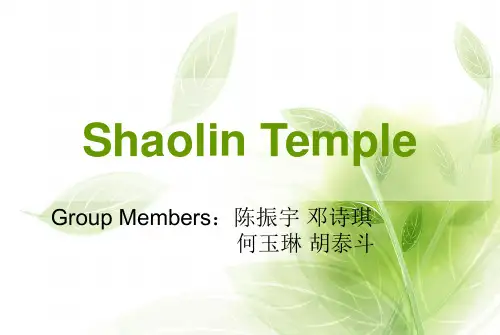
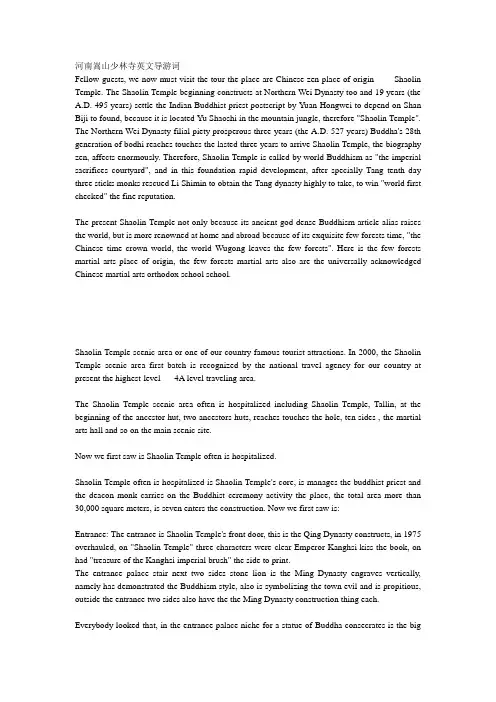
河南嵩山少林寺英文导游词Fellow guests, we now must visit the tour the place are Chinese zen place of origin ----- Shaolin Temple. The Shaolin Temple beginning constructs at Northern Wei Dynasty too and 19 years (the A.D. 495 years) settle the Indian Buddhist priest postscript by Yuan Hongwei to depend on Shan Biji to found, because it is located Yu Shaoshi in the mountain jungle, therefore "Shaolin Temple". The Northern Wei Dynasty filial piety prosperous three years (the A.D. 527 years) Buddha's 28th generation of bodhi reaches touches the lasted three years to arrive Shaolin Temple, the biography zen, affects enormously. Therefore, Shaolin Temple is called by world Buddhism as "the imperial sacrifices courtyard", and in this foundation rapid development, after specially Tang tenth day three sticks monks rescued Li Shimin to obtain the Tang dynasty highly to take, to win "world first checked" the fine reputation.The present Shaolin Temple not only because its ancient god dense Buddhism article alias raises the world, but is more renowned at home and abroad because of its exquisite few forests time, "the Chinese time crown world, the world Wugong leaves the few forests". Here is the few forests martial arts place of origin, the few forests martial arts also are the universally acknowledged Chinese martial arts orthodox school school.Shaolin Temple scenic area or one of our country famous tourist attractions. In 2000, the Shaolin Temple scenic area first batch is recognized by the national travel agency for our country at present the highest-level ----4A level traveling area.The Shaolin Temple scenic area often is hospitalized including Shaolin Temple, Tallin, at the beginning of the ancestor hut, two ancestors huts, reaches touches the hole, ten sides , the martial arts hall and so on the main scenic site.Now we first saw is Shaolin Temple often is hospitalized.Shaolin Temple often is hospitalized is Shaolin Temple's core, is manages the buddhist priest and the deacon monk carries on the Buddhist ceremony activity the place, the total area more than 30,000 square meters, is seven enters the construction. Now we first saw is:Entrance: The entrance is Shaolin Temple's front door, this is the Qing Dynasty constructs, in 1975 overhauled, on "Shaolin Temple" three characters were clear Emperor Kanghsi kiss the book, on had "treasure of the Kanghsi imperial brush" the side to print.The entrance palace stair next two sides stone lion is the Ming Dynasty engraves vertically, namely has demonstrated the Buddhism style, also is symbolizing the town evil and is propitious, outside the entrance two sides also have the the Ming Dynasty construction thing each.Everybody looked that, in the entrance palace niche for a statue of Buddha consecrates is the bigstomach Maitreya religion Buddha name welcomes guests Buddha, his benign countenance, smiles welcomes your arrival. We are called Maitreya religion Buddha "the solemn grave entrance happy to look the glory illuminates, laughs welcomes the coming person to pray for heavenly blessing extremely happy is infinite".Behind the entrance palace niche for a statue of Buddha consecrates is the Bodhisattva, the person protects buddhist law Jin'gang, it grasps the Jin'gang valuable pestle, protects temple Buddha, the law, the monk three treasures security.We looked the entrance road two sides have many stele carvings, the personal Shaolin Temple stele forest, since these all have been the Tang Song's famous primitive stele carvings. Stele forest is the kind cloud hall former site, presently for the Shaolin Temple tablet porch, it not only is recording the temple prosperity and decline condition, moreover in history, carving, artistic aspect, also has the very high research value, the Shaolin Temple stele forest and the tablet porch total has stele carving 108.Stele forest west side is the hammer spectrum hall, here winding corridor week 42, it used the clay sculpture and the woodcarving and so on vividly had demonstrated the Shaolin Temple martial arts origin, the development, exercised martial arts, the essence repertoire, the national defense function, the monk soldier fights content and so on mark, martial arts activity, altogether Chen unfolded 14 groups of 216 hammers spectra picture. Has meditates, runs after circles Buddha, eight sections of brocades, the small red fist, the scarlet fist, passes the arm fist, Luo Hanquan, the illustrious positive fist, practices the basic skills, 13 sticks monk rescues Qin Wang, the hill buddhist priest holds commander-in-chief to go to battle, the month spatial master even Japanese pirate as well as the vulgar family disciple practices the fist to practice martial arts and so on. The slang stated that, In the hammer spectrum hall five minutes, come out a body few forests merit, everybody may practice the few forests merit according to these cast postures.The Son of Heaven palace we now saw was second enters constructs the Son of Heaven palace, the Son of Heaven palace original construction three is burned down in 1928. This was in 1982 repairs, outside palace gate two big Jin'gang, the biography will be "humph", "Kazak" two, the responsibility protects the Buddhist doctrine. The main hall inside models is four great heavenly gods, also called four big Jin'gang, their responsibility inspects the all living things good and evil behavior, helps the distressed, falls the lucky world. The people according to the four great heavenly gods the combination characteristic, the implication "the good crop weather".is entire temple central construction, is the Buddhist priest carries on the Buddhist ceremony activity the important place, this palace and the Son of Heaven palace three are equally burned down in 1928 by the warlord. This was in 1985 reconstructs. This palace is the surface extravagant five double-eaved roofs rests Shan Shi to construct. In the palace center consecrates is present world Buddha ---- Buddha Tathagata buddha, left for passes Buddha ---- East only colored glaze world pharmacist Buddha, right for future Buddha ----- west extremely happy world Amida Buddha, the palace west gable will hang models is , after the screen wall the wall will hang models is the view world sound. Shaolin Temple to here about respectively models with othertemple different occupying has reaches touches the founder and is been called the Shaolin Temple stick technique founder to tighten that Luo king. Moreover, has under two big columns among this palace also to have the unicorn statue, had indicated zen Buddhism is China's -like Buddhism which completely sinicizes.the first two sides construction for the clock, the drum two buildings, southeast is a bell tower, southwest is a drumtower, the original construction destroyed in 1928 warfare, in 1994 carried on has repaired, they were the temple fixed construction. We often said are the temple monk daily life and carry on the Buddhist ceremony activity one kind of signal.In front of the bell tower this stele carving is "Emperor the Lofty Mountain Shaolin Temple Tablet" is named "Li Shimin Tablet", it engraves stands founds a nation for 16 years to Emperor Xuanzong in Tanh dynasty (the A.D. 728 years). Directly is person and so on Li Shimin Shaolin Temple seat of honor temple host teaches the article, commended the Shaolin Temple monk to help Tang to still Wang Shichong's meritorious military service, was right the fifth line to have the Li Shimin own handwriting to initial "the world people" two characters, the stele carving "too Emperor Zong Wen the imperial book" seven large brush-written Chinese characters is Emperor Xuanzong in Tanh dynasty Li Longji the imperial book. Back engraves is Li Shimin "Bestows Shaolin Temple Bai Guzhuang the Imperial Book ", recorded 13 sticks monks to rescue Qin Wang's story, also was the historical basis which the movie "Shaolin Temple" photographed. ×Ö´®9"Li Shimin Tablet" the north is "a Hill Zen master Line of Solid Tablet", has recorded Shaolin Temple Cao Dongzong the 24th generation of biography law Zen master's experience and inspires the few forests zen again the merit. Its back is " All sorts of people Tablet", above the quarter has Buddha, the road, the meek Confucianism, Buddhism, Daoism picture, this tablet had reflected Mt. Songshan is Buddha, the road, the meek Confucianism, Buddhism, Daoism gathers together the place, has manifested the Confucianism, Buddhism, Daoism confluence important thought. Again we saw toward the north was the clear Qian Long 15 years (in 1750) vertically engraves "Qian Long Imperial Tablet". The inscribed text is a poem with five characters per line: Tomorrow will gaze the mountain, tonight will sleep the few forests, the heart according to six imperial sacrifices static, the temple will be deep according to Wanshan, sets up the ancient customs to keep the sound, the earth deities evening does cloudyly, will be supposed to teach half crag rain, will send my night of window to recite. ×Ö´®1the palace tightens that Luo palace, reconstructed in 1982, in modelled tightens that Luo Wang is the Shaolin Temple unique protection god. Here had demonstrated tightens that Luo Wang , the Dharmakaya, should the body three kind of different images.West the side and tightens that Luo palace relatively is six . Was in 1982 reconstructs, in the palace directly consecrated is the situation to the Bodhisattva, the Manjusri Bodhisattva, the goddess of mercy, the Pu virtuous Bodhisattva, the Bodhisattva, two sides consecrated are at the beginning of the zen the ancestor reach touch, two ancestors brightly may, three ancestors monks Can, four ancestors say the letter, five ancestors greatly endured, six ancestors are bright energy, the personal six ancestors did obeisance the Goddess of Mercy. West six west wall is the large-scalepainted sculpture "reaches touches only treads on turns over to the chart".The Buddhist scriptures Chinese style pavilion also named the court of law, the Ming Dynasty constructs, destroys in 1928, in 1994 reconstructed, it was the temple monk Buddhist scriptures view place. In the white marble which presents as a gift in 1996 likes for a Shaolin Temple's Burmese country disciple. Has a big iron saucepan under the Buddhist scriptures Chinese style pavilion platform, is the the Ming Dynasty ten thousand all previous years casting, it is said the Shaolin Temple buddhist priest uses for the small pot at that time which the stir-fried dish uses, was allowed to imagine from this pot to the Shaolin Temple duplicate then prosperity and prosperous. 字串6The Buddhist scriptures Chinese style pavilion east and west wings respectively are east the meditation room, west the reception room, east the meditation room is a place which meditates for the Buddhist priest, west the reception room presently for receives the guest the place.The side is Shaolin Temple abbot/abbess the monk (also is abbot) the daily life, the life, director's place. The Qian Long 15 years on September 29, Qian Long travels for pleasure when Mt. Songshan once in this lodgings. Side entrance Zhong Weiyuan a generation of casting, this clock only can in encounter in the emergency case only then to strike it, plays reports to the police the role.Reaches touches the pavilion name to set up the snow pavilion. In the palace center consecrates is the copper nature reaches touches , two sides respectively are two ancestors are bright may, three ancestors monks Can, four ancestors say the letter, five ancestors greatly endure. In the palace is hanging "the snow India heart bead" four characters is Emperor Qian Long the imperial topic. Said reaches touches the pavilion also to have a moving story. According to the Buddhism classics records: After reaches touches arrives Shaolin Temple, some Chinese eminent monk god light also follows to come, modestly to reaches touches seeks for advice, reaches touches the rejection, the god light certainly is not discouraged. Reaches touches to the pit hole faces the wall to meditate, the god light stands after that, reaches touches the temple to attend to the Buddhist ceremony, the god light also with returns to the temple, the god light to reaches touches the intensive care, always is together. To Zen master's every action and every movement, the heart pleased takes orally, like this day after day, year after year. A.D. a 536 years winter night, reaches touches in reached touches the pavilion to meditate sits in meditation, the god light stands as before outside the pavilion, by now under the space got up the heavy snow, the heavy snow submerged the god light double knee, the god light still, as soon as moved also motionless, after second days early reached higher authorities to touch decide, saw the god light to stand in the snowy area, asked him: "What do you stand in the snowy area do?" The god light replied: "Asks skilled worker really to teach method." Reaches touches said that, "Wants me to pass on the law to you, only if the day is prosperous ."God photolysis Italy, extracts abstains the knife, has struck off from already the left arm, the blood seven red white snows, have reached immediately touch the heart movement, then has bequeathed the god light the clothes earthen bowl Buddhist musical istrument, the achievement passing on method certificate, and names for it is "is bright may". We now said "clothes earthen bowl trueline" the idiom story is the source to this. "Breaks the arm asks the law" the story also continuously for the imperial sacrifices to be on everybody's lips. At the same time, for commemorates two ancestors to be bright may set up the snow to break the arm to obtain the Buddhist doctrine, the people called "reaches touches the pavilion" is "sets up the snow pavilion".Reaches touches pavilion is the Manjusri palace, in the palace consecrates is the Manjusri Bodhisattva, gets down everybody to follow me to visit the Shaolin Temple highest main hall, certainly also is the most precious palace. Thousand Buddhist temple hall thousand Buddhist temple hall is Ming Dynasty construction, is the Shaolin Temple courtyard last the construction, the other name adjoins the Lu Chinese style pavilion, the palace high 20 meters, the area 300 square meters, is in the temple most Buddhist temple hall, in the palace center consecrates is adjoins the Lu Buddha (namely Buddha Buddha's Dharmakaya) on to be hanging "law India high to raise" the inscribed horizontal tablet is clear Emperor Qian Long the imperial book, the palace , northwest, on three walls is 500 Luo Han Dynasty which the Ming Dynasty draws up adjoins the Lu large-scale color painting, stems from the Ming Dynasty not to have hand of picture Italy famous painter to be fine, the design boldly has the very high artistic research value. We looked toward the place on that, in the palace in the brick shop bottom surface has 4 rows of 48 stations piles pit, they are the foot pit ruins which all previous years Shaolin Temple monk practices boxing , we may become fewer the forest time from these foot pits .Thousand Buddhist temple hall east side is the Goddess of Mercy palace other name hammer spectrum palace, in the palace consecrates Guanyin, namely goddess of mercy. In the palace on the wall is clear center later period plan Shaolin TempleWest thousand Buddhist temple hall is the repositry for buddhist scriptures, among the palace consecrates is Ksitigarbha, stands in the Ksitigarbha south side is the reply elder, north the side is a bright buddhist priest, in the palace the north and south both sides wall plan is "ten palaces Mr. Yan", west side the wall plan is "24 filial piety charts".Fellow friends, ask everybody to return according to the old route, our below visits is the country key cultural relic preservation organ ---- Shaolin Temple Tallin.The Shaolin Temple Tallin is all previous dynasties Shaolin Temple eminent monk's tomb, the total area 14,000 square meters, in 1996 the State Council announced for the national level key cultural relic preservation organ. Tallin extant Tang, Song, the gold, Yuan, are bright, clear each generation of bricks and stones grave tower 240, Tang tower 2, the Song tower 2, the Chinta 10, the Yuan tower 46, bright tower 148, other the tower which are unclear for the clear tower and Song Dynasty. The Shaolin Temple Tallin is in our country extant ancient tower group the scale biggest, the quantity most ancient towers group, here tower high generally below 15 meters, is different from a level to seven levels, Ming Ta height, the size, the level, the construction are according to the buddhist priest before death in Buddhism's status, the Buddhist studies attainments, the quantity, the prestigious height, the economical condition and the historical condition decides.The Shaolin Temple tower Lin Zhongdi famous tower includes: Tang Zhenyuan seven years (A.D.791 years) the law played the Zen master tower, the Song three years (in 1121) ordinary tower, Jin Zhenglong two years (in 1157) west Tang tower, bright Wanli eight years (in 1580) confident pinnacle, clear Kanghsi five years (in 1666) the other shore tower, after a Yuan generation () the chrysanthemum hut elder tower which (in 1339) built to a Yuan five year and so on. Tallin was studies our country the ancient architecture history, the carving, the calligraphy, the artistic history and the religious culture precious buried treasure.Under we continue to at the beginning of ancestor hut visit.Now for everybody simply introduced at the beginning of ancestor hut, initially the ancestor hut is located Shaolin Temple five under, in on the Shaolin Temple temple behind hillside, is the descendant disciple which reaches touches reaches for the commemoration touches faces the wall to construct. Area 7,760 square meters, at the beginning of ancestor hut main hall for Song Dynasty model wood construction construction, now for national level key cultural relic preservation organ. Now we go to two ancestors huts visit while the place rope way.Two ancestors huts are located in the Shaolin Temple earthen bowl jade peak, it is the Shaolin Temple highest construction, is two ancestors is bright may construct, because its and at the beginning of ancestor hut north and south south isologue therefore calls the hut. After the fable two ancestors were bright may set up the snow cliff once to convalesce in this.Reaches touches the hole to be located Shaolin Temple northwest five on, the pit hole deep approximately 7 meters, the height 3 meters, the width 3.5 meters, from the A.D. 527 years to 536 years, reach touch face the wall for nine years in this, finally becomes the fruits of virtue, the biography zen, becomes in the Buddhism history the great pioneering work. Here has ten sides which the Ming Dynasty constructs, both sides the hole on the precipice has many place carved stone which all previous dynasties celebrity stays behind.Receives us to visit the Shaolin Temple opposite ten sides .The Shaolin Temple opposite few brooks river Nanan is the cubic meter of stone , constructed in seven years (in 1512), clear along governed for ten years to repair, was the temple courier's lodge, is a place which the good foot Buddhist priest stayed, in 1958 collapsed, in 1993 repaired. The newly built ten sides and past were different, was group of new Buddhism imperial sacrifices scenery ----- 500 Luo Hantang.Ten Fang Naizheng about four corners ten positions.Four: East constructs has, west, south, north four Shan Yanxie the mountain type palace.Four corners: Constructs has the spring, the summer, the fall, the winter four each characteristic scenery circle.Ten sides designs exquisite, plain is elegant, it is one of Shaolin Temple main scenic sites.Good, fellow tourists, Shaolin Temple's visit must finish, welcome everybody to have the opportunity to arrive Shaolin Temple to visit the traveling again, studied the fist , thanks.。
英语作文介绍河南少林寺Shaolin Temple, located at the foot of Mount Song in Henan Province, China, is widely regarded as the birthplace of Zen Buddhism and the cradle of Kung Fu. With a history of over 1500 years, it has attracted millions of visitors from all over the world and has been acknowledged as a UNESCO World Cultural Heritage Site.The temple was built in 495 AD during the Northern Wei Dynasty by Emperor Xiaowen in honor of an Indian monk named Batuo, who came to China to spread Buddhism. It was later famous for its association with Bodhidharma, an Indian monk who is traditionally credited with bringing Chan Buddhism to China and founding Zen Buddhism. With its long history and rich cultural heritage, Shaolin Temple has become an important religious and cultural landmark in China.Over the centuries, Shaolin Temple has also been knownfor its unique martial arts tradition. The monks of Shaolin Temple have developed a distinctive style of Kung Fu, characterized by its emphasis on strength, agility, and spiritual discipline. This style of Kung Fu, known as Shaolin Kung Fu, has become world-renowned and has influenced the development of many other martial arts styles throughout the world.In addition to its martial arts tradition, Shaolin Temple is also famous for its remarkable architecture. The temple complex covers an area of 54,000 square meters and is comprised of numerous halls, pagodas, and courtyards. The main hall of the temple, known as the Mahavira Hall, is home to a statue of Sakyamuni, the founder of Buddhism. The Pagoda Forest, a collection of ancient pagodas housing the remains of eminent monks, is another notable feature of the temple.Every year, Shaolin Temple attracts thousands of tourists and pilgrims who come to admire its ancient architecture, learn about its rich history, and witness the skill and discipline of its Kung Fu practitioners. In recent years, the temple has also become a popular destination for martial arts enthusiasts and tourists seeking to experience the unique culture and traditions of Shaolin.In conclusion, Shaolin Temple is a treasure trove of history, culture, and martial arts. Its ancient architecture, rich history, and unique Kung Fu tradition make it a must-see destination for anyone interested in Chinese culture and history. As the birthplace of Zen Buddhism and the home of Shaolin Kung Fu, Shaolin Temple continues to inspire and captivate visitors from all over the world.。
英语作文介绍河南少林寺Title: An Introduction to Henan's Shaolin T empleShaolin Temple, located in Henan Province, China, is renowned for its rich history and profound influence on martial arts. As one of the most famous Buddhist temples in the world, it attracts numerous visitors and martial arts enthusiasts every year.Established in the 5th century, Shaolin Temple is considered the birthplace of Chinese martial arts, also known as Kung Fu. It was founded by an Indian monk named Bodhidharma, who is said to have introduced Buddhism and meditation techniques to the temple. Over the centuries, the temple has become a sanctuary for martial artists, where they practice and refine their skills.Situated at the foot of the Songshan Mountains, Shaolin Temple is surrounded by breathtaking scenery. The temple complex consists of various halls, pavilions, and pagodas, showcasing traditional Chinese architecture. The most famous structures include the Hall of Heavenly Kings, the Main Hall, and the Pagoda Forest.One of the highlights of Shaolin Temple is the martial arts performances given by the monks. These showcases demonstrate the monks' incredible strength, speed, and agility, as well as the wide range of martial arts techniques they have mastered. Visitors are often in awe of the monks' ability to perform intricate movements and stunts, whichhave been passed down through generations.Shaolin Temple is also known for its unique form of meditation, called \'Chan\' in Chinese, or Zen in Japanese. This practice focuses on achieving enlightenment through mindfulness and self-discipline. The monks at Shaolin Temple spend years perfecting their meditation techniques, which contribute to their physical and mental well-being.In addition to martial arts and meditation, Shaolin Temple is a place of historical significance. It has been destroyed and rebuilt several times throughout its history, reflecting the turbulent periods China has endured. The temple's architecture and ancient artifacts provide valuable insights into China's cultural heritage.Today, Shaolin Temple is not only a place for religious worship and martial arts practice but also a popular tourist destination. Visitors can explore the temple's grounds, learn about its history, and even participate in martial arts training courses. The temple has also been featured in numerous films and television series, further enhancing its global reputation.In conclusion, Henan's Shaolin Temple is a treasure trove of martial arts, Buddhism, and Chinese history. Its cultural significance and stunning architecture make it an unforgettable destination for travelers interested in exploring the depth of China's rich traditions.。